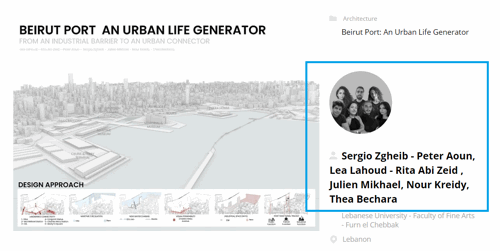Svitanok

Idea projektu
“Svitanok” – Eco-Educational Community Centre in Stryi, Ukraine
Author: Dariia Telesniuk
“Svitanok” (Ukrainian for “Sunrise”) is a humanitarian architectural project created as a response to the urgent need for social recovery and community support in post-war Ukraine. The building is conceived as a multifunctional public space that promotes education, environmental awareness, and intergenerational dialogue.
Located on Ivan Pavlo II Street in the centre of Stryi, the project builds on the site's strong social context — surrounded by schools, parks, religious and cultural institutions — and transforms it into a dynamic civic hub. The site boundaries were intentionally expanded during the design process to incorporate an adjacent green courtyard, turning it into an open public yard. An existing building on the plot was also fully integrated into the new structure rather than partially demolished. This decision provided architectural clarity, spatial unity, and the ability to accommodate the full program efficiently.
Architecturally, the project reflects the local identity through traditional pitched roofs, blending into the surrounding built fabric. The southern glazed volume functions as a greenhouse-like space that pays tribute to the garden formerly located on the site, preserving its memory and inviting sunlight deep into the interior. Additionally, the design features a Ukrainian folk ornament embedded into the building elements to symbolise cultural continuity and pride.
“Svitanok” aims to become not just a building, but a symbol of hope, resilience, and rebirth — a space where people can heal, gather, learn, and grow together.
Popis projektu
The “Svitanok” Eco-Educational Community Centre was designed to serve as a vibrant social, educational, and cultural hub in the heart of Stryi. The scope of the project goes beyond architectural design — it aims to revitalise the urban environment, preserve memory, and empower the community through inclusive programming and sustainable solutions.
The building responds to a complex set of needs: creating a safe post-war space for social gathering, supporting educational activities for all generations, promoting local entrepreneurship, and offering space for civic events. The project is designed with multifunctionality and flexibility at its core, allowing spaces to adapt over time based on the community’s changing needs.
The first floor serves as the active public zone, welcoming users with a reception area, small commercial units, a café, and a co-working space. The co-working zone is visually and physically connected to the café, encouraging spontaneous interaction between visitors, local entrepreneurs, and residents. This creates a dynamic and approachable space for work, rest, and informal communication.
The second floor is designed to accommodate administrative offices, community gathering spaces, and flexible educational zones. These areas can be reconfigured to form a multifunctional event hall, making this level ideal for public lectures, exhibitions, training sessions, or cultural gatherings. A key feature of this floor is its direct access to the roof terrace of the southern greenhouse volume, extending the usable space and offering an open-air area for events or relaxation.
The third floor is dedicated to children’s education and developmental activities. The layout includes learning rooms and creative zones, which can also be transformed into a multifunctional space for children’s performances, workshops, or play-based events. This floor additionally provides access to the upper part of the roof, enhancing the indoor-outdoor learning environment and enabling direct contact with nature and fresh air.
The underground level, accessible via two separate entrances, houses a bunker (emergency shelter) and technical infrastructure, such as mechanical rooms and utility spaces. This level supports the building’s resilience and safety, ensuring it remains functional during emergencies or power interruptions.
The overall scope includes urban revitalisation, adaptive use of land, full integration of an existing structure, and expansion of public space through the conversion of a previously fenced courtyard into a shared green yard for the neighbourhood. The design thoughtfully connects architecture, ecology, and community into a unified, accessible, and meaningful place for the people of Stryi.
Technické informace
The “Svitanok” Eco-Educational Center is a three-story timber building with an underground level, located on Ivan Pavlo II Street in the central part of Stryi, Ukraine. The total structure is designed using a sustainable wooden framework, offering a reduced carbon footprint, superior thermal insulation, and a warm, natural interior atmosphere.
The building footprint was intentionally expanded beyond the original competition site to include an adjacent green courtyard, transforming it into a public open yard. Additionally, instead of partially demolishing an existing building on-site, the full structure was integrated into the new design, which enabled architectural clarity and made it possible to accommodate the entire functional program without spatial compromise.
The architectural form is characterised by pitched roofs, echoing the traditional rooflines of Stryi and ensuring that the building blends harmoniously with its urban context. The southern volume is fully glazed, forming a greenhouse-like façade that invites abundant daylight and symbolically preserves the memory of the garden that once occupied the site. This space also functions as a focal point — a visual and social anchor that connects nature, memory, and modern design.
The project incorporates a Ukrainian folk ornament into the architectural language, subtly embedded in surfaces and finishes. This gesture honours national identity and cultural continuity.
Program distribution by floor:
Ground floor: Reception area, commercial spaces (shops), café, co-working space
First floor: Office space, community rooms, flexible educational zones, multifunctional hall, access to greenhouse roof
Second floor: Children’s educational spaces, multifunctional hall for kids, access to the upper roof
Underground level: Bunker (emergency shelter), technical and mechanical rooms, accessible via two separate entrances
Sustainable and technical features include:
Timber construction with high thermal performance
Green roof for temperature regulation and biodiversity
Rainwater harvesting and natural ventilation
Solar panels for renewable energy use
Accessibility for all users, with barrier-free entry and circulation
Integration with public transport, pedestrian and cycling routes
The Svitanok Center follows principles of ecological responsibility, adaptive urban planning, and social resilience. It is a safe, flexible, and inclusive architectural response to the challenges of post-war reconstruction — a space designed to grow together with its community.







